The History of the German Navy
The German Navy of today was founded during the Cold War. From 1956 on, this federal navy was West Germany’s naval force. In 1990, it once again became the navy for all of Germany.
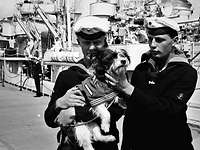


The German Navy of today was founded during the Cold War. From 1956 on, this federal navy was West Germany’s naval force. In 1990, it once again became the navy for all of Germany.

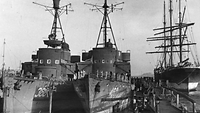
After the war, former members of the Kriegsmarine – the navy of Nazi Germany – served in the “German Mine Sweeping Administration” for the Allies. Shown here are old minesweepers in Kiel in 1949.
Bundesarchiv, Bild 183-2005-0715-510/CC-BY-SA 3.0After the Wehrmacht’s capitulation on 8 and 9 May 1945, there was no longer a German fleet. There was, however, an urgent task that only a navy could perform. During World War II, all of the warring parties had planted some 580,000 sea mines in European waters. The safety of these sea routes had to be restored.
For that reason, hundreds of former members of the Kriegsmarine – the navy of Nazi Germany – once again served on their old minesweepers, this time under British and USUnited States command. By the early 1950s, they had removed virtually all of the mines from 5,600 square nautical miles in the North Sea and 450 square nautical miles in the western Baltic Sea. Later, these groups were disbanded and partially absorbed into the West German maritime border guard that had been founded by that point.
In the course of German rearmament, West Germany also began to form a navy again starting in 1956. The new Naval Staff in the Federal Ministry of Defence was headed up by the first Chief of the German Navy, Friedrich Ruge, until 1961. He had fought in two world wars and most recently risen to the rank of Vice Admiral in the Kriegsmarine.
In Wilhelmshaven, the former naval port of the Imperial Navy, the Bundeswehr initially set up a Navy demonstration company. The young West German navy’s first military personnel then included the veteran sailors from the maritime border guard.
From the beginning, the Federal Republic of Germany’s naval forces have been closely integrated into NATONorth Atlantic Treaty Organization. To this day, the German Navy sees itself first and foremost as an Alliance navy. Its task during the confrontation with the Soviet Eastern Bloc was defending access to the Baltic Sea and the western Baltic Sea, as well as the sea routes in the North Sea, in cooperation with allied navies – first and foremost those of Denmark, Norway and the United Kingdom. This mission remained virtually unchanged until the end of the 1980s. Only the plans for landing operations on the Baltic coast, which the West German army was to have supported, were abandoned in the 1960s.
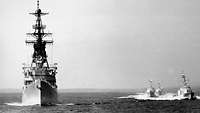
The Lütjens destroyer and three of the West German navy’s Tiger-class missile-armed fast attack boats in the North Sea circa 1985.
BundeswehrFor that reason, the first shipbuilding plan approved by the German Bundestag called for not only twelve destroyers and six frigates, but most notably a fleet with many specialised vessels: 40 motor torpedo boats, 24 coastal minesweepers, 30 high-speed minesweepers, 36 landing craft, 10 coastal patrol boats and 12 submarines, as well as 11 tenders as supplying ships for all the others. Two large minelayers, a modern training ship, a sail training ship and various auxiliary craft, test vehicles and exercise vehicles were also to be acquired.
Nevertheless, the new Navy was initially built around vessels from the former Kriegsmarine, which Germany’s former adversaries gave back, along with the vessels that Germany purchased from its new allies. That is why the West German fleet already had 65 ships and vessels, as well as 7,700 personnel, by December 1956. By the 1980s, it would grow to over 35,000 military personnel.
This federal navy’s most combat-effective ships were probably the three large Lütjens-class guided missile destroyers. They were built in the USUnited States in the late 1960s, based on modified plans from ships that were also in use in the USUnited States Navy. Originally intended for convoy protection in the North Atlantic and the North Sea, the destroyers were ultimately stationed in Kiel – a clear message of deterrence for the potential adversary to the east.
The West German navy did not start out with a clean slate in 1956. Its command personnel in particular had a background in two world wars.
Friedrich Oskar Ruge lived and worked in four different navies – but had the greatest impact starting in 1957 as the first chief of the West German navy for the new democratic armed forces. Born into a middle-class family in Leipzig in 1894, he joined the Imperial Navy as an officer candidate in 1914. He experienced World War I as a mix of training and operations in the North Sea and the Baltic Sea. In the Reichsmarine, which replaced the Imperial Navy, he rose to the rank of Commander of 1 Minesweeping Flotilla. Afterwards, he went on to become head of the naval shipbuilding office in the Kriegsmarine. His last rank: vice admiral.
After the end of World War II, Ruge completed the denazification process and was exonerated of guilt. He then worked as a translator before becoming a member of the USUnited States Office of Naval Intelligence’s Naval Historical Team in 1949. This group of former Wehrmacht naval officers were assigned to analyse their war experiences so that the USUnited States Navy could use them against the Soviet fleet if necessary. The first plans for a new West German navy were also made in this setting.
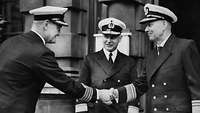
With rearmament came reconciliation: Vice Admiral Friedrich Ruge, the first Chief of the German Navy (on the right), shown here at a July 1957 inaugural visit to the Royal Navy in London.
Getty ImagesIn 1955, Ruge joined what was to become the Federal Ministry of Defence. First as Director of Directorate-General VII: Navy, then as Chief of the German Navy in his old and new rank of vice admiral, he oversaw West Germany’s naval rearmament. He had been reviewed by the selection board beforehand. This board reviewed veteran officers before their employment in the new Bundeswehr to find out whether they had been members of the NSDAP (the Nazi Party) or been involved in possible Nazi crimes.
Ruge finally retired six years later. However, he continued to play an active role in society for many years, for example as President of the Bundeswehr Reservist Association, as an honorary professor of political science in Tübingen or as a military adviser for the Hollywood film The Longest Day. He died in 1985 in Tübingen.

„What are the most important skills for a naval officer to have? He needs to be able to lead people. He needs to be able to command ships. And he needs to be able to bear arms. Everything else is secondary“
The German Navy of today has over 60 years of experience – from the Cold War until 1990, and from the operations since it was founded in 1956.
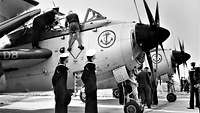
Open Day for the Navy in 1958: the Fairey Gannet Mk4 was a carrier-borne antisubmarine aircraft of the Royal Navy. The West German navy also employed 16 aircraft of this type from 1958 to 1966.
Bundeswehr/Müller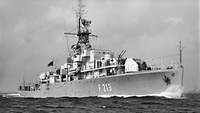
The new West German navy received its first ships from its former adversaries. The Scharnhorst was one of the West German fleet’s four training frigates, which it received from the British Royal Navy. They remained in service until 1968.
Bundeswehr
Back when shipboard dogs were still allowed: Private Tramp of 3 Minesweeper Squadron in 1963.
Bundeswehr/Oed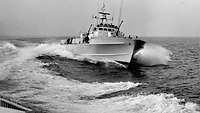
A Jaguar-class motor torpedo boat at full speed. The German Navy’s first fighting craft that were developed after the war were in service from 1959 to 1976.
Bundeswehr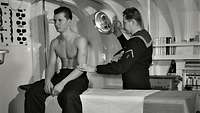
In the medical room of the Hipper training frigate, 1959. The ship had been launched as “Actaeon” for the Royal Navy in 1945.
Bundeswehr/Baumann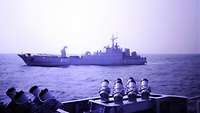
The two Germanies meet: the West German navy regularly encountered the East German navy in the Baltic Sea. Shown here is the East German navy’s Südperd oceangoing supply ship, photographed from the West German navy’s Hameln minesweeper in 1990.
Wikimedia Commons/HeldImFeld/CC BY-SA 4.0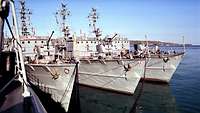
Lindau-class minehunters participated in Operation Südflanke in 1991. They removed sea mines from the Persian Gulf after the end of the Gulf War. Most importantly, these activities demonstrated the Alliance solidarity of the recently reunified …
Bundeswehr/Funk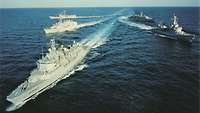
Participating in the NATONorth Atlantic Treaty Organization and WEUWesteuropäische Union Operation Sharp Guard from 1993 to 1996 was one of the German Navy’s first operations. Two NATONorth Atlantic Treaty Organization naval forces, each of which always included a German naval ship, were provided on a rotational basis for this purpose.
NATO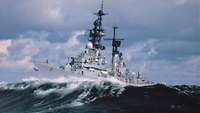
The German Navy’s last destroyers, which were built in the late 1960s, had controversial names. Shown here is the Mölders, named after Werner Mölders, one of the most decorated fighter pilots in the Wehrmacht. It was decommissioned in 2003.
Bundeswehr/Wetterman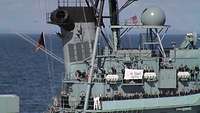
Decades of cooperation have made the German Navy into a true Alliance navy. Here, the crew of the Lütjens destroyer express their sympathy to their American fellow soldiers a few days after the attacks of 11 September 2001.
US Navy/Shane McCoyAfter German reunification on 3 October 1990, parts of the East German navy, which had been disbanded the day before, were integrated into the German Navy. Almost 2,000 temporary-career volunteers and career service members were absorbed into what had previously been the West German navy. However, with very few exceptions, the Bundeswehr scrapped or sold the East German fleet’s ships and vessels in 1991.
After a transition period with a partly separate Navy Headquarters in Rostock, the German Navy was reorganised in 1995. Units stationed in the former East Germany were now also assigned to NATONorth Atlantic Treaty Organization. At this point, the German Navy also abandoned its informal designation as the “federal navy”. In the spirit of the new national unity, it was now known as the German Navy.
Reunification in 1990 radically changed Germany’s geopolitical environment. The country on both sides of the former inner German border was no longer on the front line of the ideological confrontation between the two blocs. As a fully sovereign country, the Federal Republic of Germany became increasingly involved in international efforts to contain or even prevent crises and conflicts.
Nevertheless, this strategic turning point also signalled the beginning of considerable disarmament and downsizing of the German Navy. By 2014, it had been reduced to just under 16,000 military personnel and fewer than 50 ships and vessels.
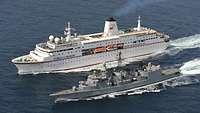
Naval ships maintain order on the high seas. Here, Frigate Rheinland-Pfalz encounters the MS Deutschland in the Gulf of Aden in 2009. The cruise ship had entered waters that were threatened by pirates.
BundeswehrOperation Südflanke (“southern flank”) was probably the German Navy’s first operation under the changed parameters. After the end of the Gulf War, German minesweepers removed Iraqi sea mines from the Persian Gulf from February through July 1991.
The German Navy subsequently participated in Operation Sharp Guard with NATONorth Atlantic Treaty Organization and the Western European Union from 1993 to 1996. A German destroyer or a German frigate was also with each of the two NATONorth Atlantic Treaty Organization naval forces employed. They enforced the international arms embargo, which the United Nations had imposed on the participants in the Yugoslav Wars, in the Adriatic Sea. However, the Germans had very limited options for action.
During this mission, the Federal Constitutional Court made its landmark ruling of 1994. From then on, the Bundeswehr’s operations abroad had to be approved by the German Bundestag. The German armed forces had become a parliamentary army. This new, clarified legal situation also gave members of the German Navy the ability to act with confidence. For example, it allowed them to board foreign ships. German naval ships were now also able to inspect potential embargo violations themselves during Operation Sharp Guard.
Since then, the German Navy has participated in many different international operations, including anti-piracy measures at the Horn of Africa, rescuing shipwrecked refugees from the Mediterranean Sea, and preventing arms smuggling into Lebanon. Even without a combat mission, the German Navy has been demonstrating since 1990 just how broad and flexible the naval forces’ task spectrum can be.
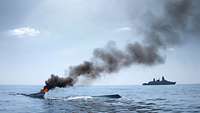
Since 2008, the German Navy has been participating in Atalanta, the EUEuropean Union’s anti-piracy operation. In 2010, Frigate Hamburg discovered a skiff floating bottom-up off the coast of Somalia.
Bundeswehr/Christian Laudan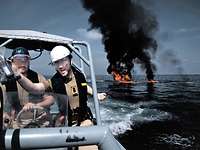
The commanding officer on the German ship had the drifting boat destroyed in order to prevent pirates from salvaging and using it.
Bundeswehr/Christian LaudanHowever, in 2014, the strategic parameters in Europe changed once again. Since the onset of the Russia-Ukraine crisis, the members of NATONorth Atlantic Treaty Organization have increased their efforts in national and collective defence – a process that is still ongoing. Germany, safely in the middle of Europe, has been providing increasing support to its allies in Eastern Europe since then.
This meant that the German Navy had to make its presence felt more in the Baltic Sea and the North Atlantic, and to train its capabilities in cooperation with its NATONorth Atlantic Treaty Organization and EUEuropean Union partners more often and more extensively than it had done in these regions since 1990.
The Bundeswehr’s naval force has a democratic history that now dates back over 170 years.
On 14 June 1848, the Frankfurt Parliament, meeting in the Paulskirche church, voted with an overwhelming majority to invest six million thalers in building an imperial fleet. Members of the first freely elected German parliament had founded the first pan-German navy.
For this reason, the German Navy celebrates the anniversary of this unprecedented, forward-looking founding moment for the first German fleet every year. It was subject to parliamentary oversight and bore the colours of the early republican movement: the black, red and gold flag.
The war between Denmark and the states of the German Confederation over the duchies of Schleswig and Holstein, which had broken out in April 1848, was the reason the fleet was established. On land, the Schleswig-Holstein rebels and Prussian troops were gradually gaining the upper hand, but the Danish fleet blocked the German ports in the North Sea and Baltic Sea, which had severe consequences for trade and the population in coastal cities. The German states had no ships of their own to counter the Danish fleet.
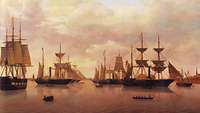
The Imperial Fleet, shown here at the roadstead near Bremerhaven in 1849. Contemporary depiction
Wikimedia Commons/Urheber unbekannt; gemeinfreiThe parliamentarians in Frankfurt had recognised the maritime dimension of security for Germany, which had been shaped by continental aspects up to that point. The new navy’s mission was offensive defence and protecting trade at sea.
After overcoming some initial problems, the Imperial Fleet consisted of eleven larger ships and a great number of rowed gunboats. Some were modified merchant ships, and others were naval ships purchased in other countries. Its main base was in the Weser estuary in Bremerhaven. In April 1849, Captain Karl Rudolf Bromme, known as “Brommy”, became commander-in-chief. He led the only battle with Danish ships, which took place off of Heligoland on 4 June 1849. The outcome was undecided.
Meanwhile, the defeat of the revolution and the end of the Frankfurt Parliament had sounded the death knell for the Imperial Fleet. Prussia was particularly active in pursuing its own naval plans. The fleet was disbanded in 1852, after which the last ships were auctioned off.
Nevertheless, the date that the Frankfurt Parliament founded the Imperial Fleet, the first pan-German navy of all time, has become an established democratic tradition. The Federal Republic of Germany’s naval forces celebrate this naval anniversary to this day.

The Frankfurt Parliament was the provisional constituent parliament of the German Empire after the revolution of 1848. By the second month after its first session, the members were already addressing the topic of a navy.
Historisches Museum Frankfurt/Ludwig von Elliott